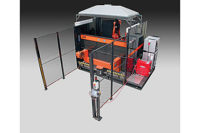Assembly Lines
Smart, Energy-Efficient Robotic Gripper Cuts Production Costs

This robotic gripper requires 90 percent less electricity than conventional devices.
Photo courtesy Saarland University/ Oliver Dietze
SAARBRUCKEN, Germany—Engineers at Saarland University recently used lightweight, shape-memory materials to create a non-pneumatic robotic gripper that can safely hold and manipulate workpieces without requiring a continuous supply of energy. The device consumes 90 percent less electricity than traditional grippers.
The electric gripper is composed of bundles of ultrafine wires made from nickel-titanium shape memory alloy (SMA). The wires act not only as powerful muscles, but as nerve fibers as well. They enable the flexible fingers to quickly adapt to changes in the shape of a workpiece.
The behavior of the wire bundles is due to a special property of nickel-titanium alloy that enables it to switch between two different crystal lattice structures. If an electric current flows through a wire made from nickel-titanium, the material heats up, causing it to adopt a different crystal structure with the result that the wire becomes shorter.
When the current is switched off, the wire cools down and returns to its earlier crystal lattice structure and its original length. The material appears to remember its original shape and to return to it after being deformed. The wires are able to exert remarkably large forces for their size and can be made to trigger tiny, controlled motions in whatever smart technology the engineers have attached to these minute artificial muscles.
“The work we’re doing can help bring about a significant reduction in energy consumption, reducing production costs as well as helping to protect the climate,” says Paul Motzki, Ph.D., professor of smart material systems for innovative production at Saarland University and CEO of the Saarbrücken Center for Mechatronics and Automation Technology. “We can control these gripper systems in real time and whenever needed. All we need to do is apply a short pulse of electric current.
“Nickel-titanium SMA has the highest energy density of all known drive mechanisms, so by using this material, we’re able to exert a substantial tensile force in very small spaces,” Motzki, points out.
A wire with a thickness of only half a millimeter can exert a pull of some 100 newtons. However, Motzki and his colleagues use bundles of much thinner, ultrafine wires, because more wires mean a greater surface area and faster cooling rates. This means that the wire muscles can deliver rapid, high frequency motions and a stable tensile force.
Using a bundle of 20 ultrafine wires, each with a diameter of only 0.025-millimeter, they can exert 5 newtons of force at a frequency of 200 hertz. In some applications, the size of the force delivered is most important, in others it is the frequency with which the force is applied.
Traditional grippers usually rely on feedback from sensors, but Motzki’s technology is self-sensing. The system is controlled by a semiconductor chip.
“The shape-memory wires effectively act as fully integrated sensors providing us with all the necessary data,” says Motzki, “An AI system precisely correlates the electrical resistance data with a particular deformation of the wires. As a result, the system always knows the exact position of each bundle of shape-memory wires.
“The data-trained neural networks are able to calculate positional information efficiently and accurately, even in the face of disruptive influences,” explains Motzki. “[We] can therefore program the system to perform highly precise movements. By specifying the electrical resistance values, we can control the wires as needed.
“Unlike standard industrial robots in use today, reprogramming is quick and easy with our system and can even be done on the fly when necessary,” claims Motzki. “The gripper can adapt to the geometry of different workpieces while operating.”Looking for a reprint of this article?
From high-res PDFs to custom plaques, order your copy today!





